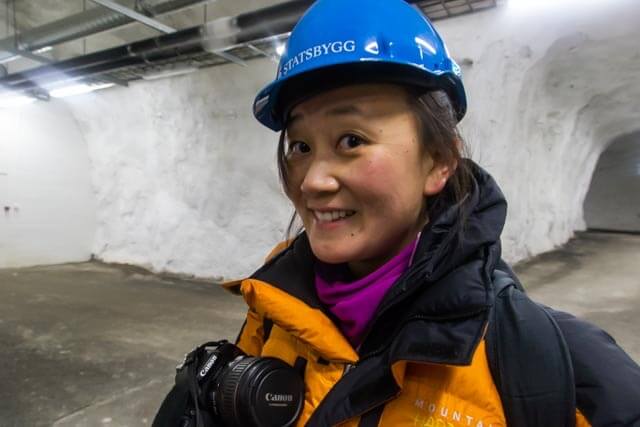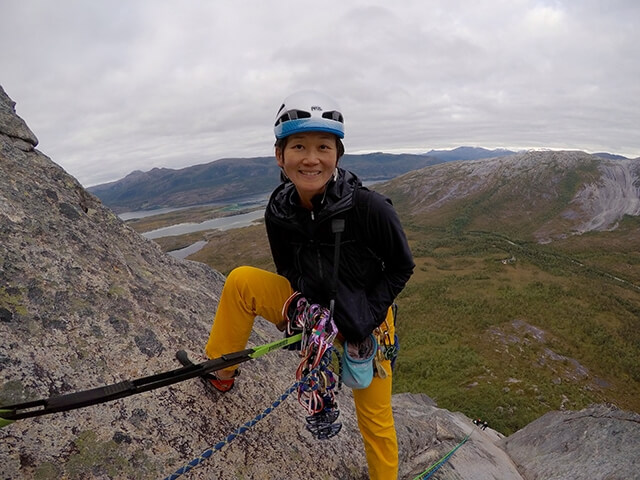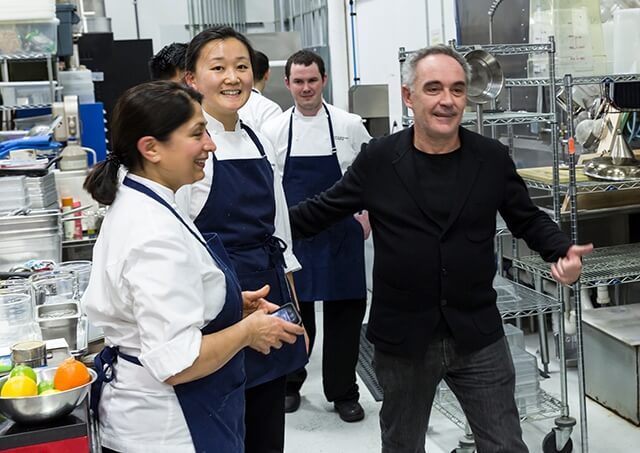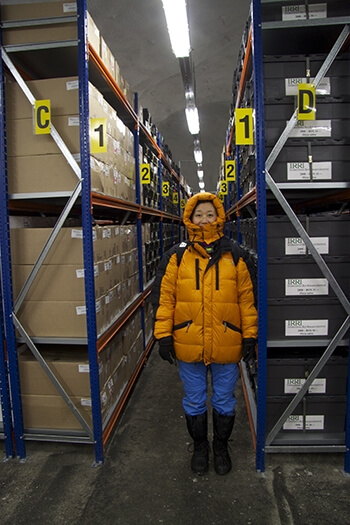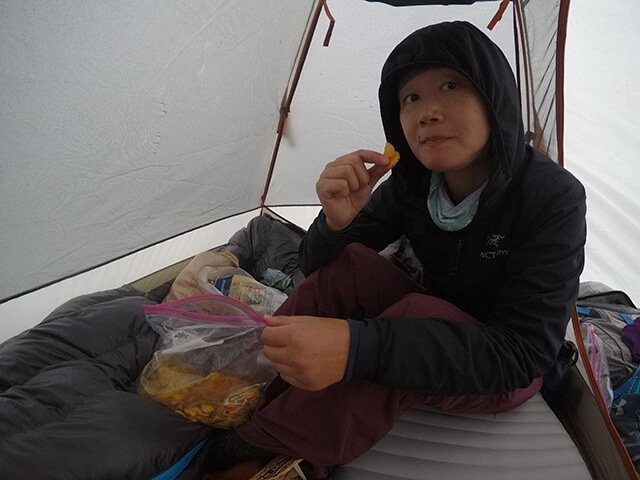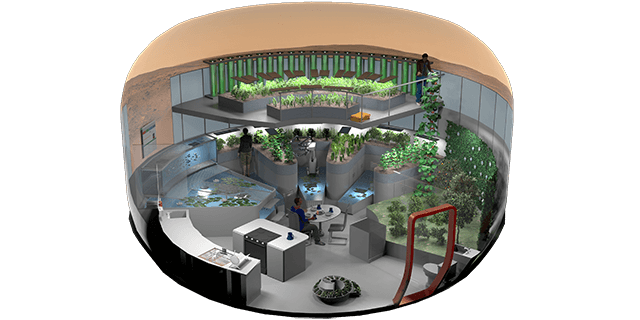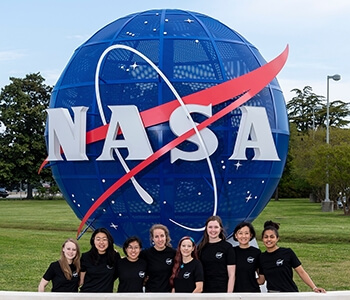Zhou inside the Svalbard Global Seed Vault in 2014 (Photo courtesy of Nathan Myhrvold).
Imagine being cooped up on a Mars-bound spaceship for seven months with nothing to eat except freeze-dried meals that, once rehydrated, only vaguely resemble “real” food.
The sharp crunch of a fresh apple or the unctuous creaminess of a soft cheese, tasty reminders of planet Earth, drift farther away as the ship moves through the blackness of space.
Improving the dining experience for astronauts has become a mission for Harvard John A. Paulson School of Engineering and Applied Sciences graduate student Larissa Zhou. She wants to understand what happens to food when enough water is removed that it becomes shelf stable.
“When you put water back into dehydrated food to rehydrate it, you don’t get the original mechanical properties back. If you remove the water from an apple, for instance, it won’t regain its crispiness when you rehydrate it,” said Zhou, a materials science and mechanical engineering Ph.D. candidate in the in the lab of David Weitz, Mallinckrodt Professor of Physics and of Applied Physics. “I want to understand, why can’t you get that crispy apple back? If we can understand that, maybe we can develop technologies to get around some of the damage that is caused during dehydration, or repair some of this damage, so you can rehydrate and restore the original texture of the food.”
Zhou climbing in Norway (Photo courtesy of Larissa Zhou).
For Zhou, working on a problem with implications for space travel is fitting—as a child, she dreamed of becoming an astronaut. Those lofty ambitions led Zhou to study physics as an undergraduate at Harvard. She gravitated towards engineering courses because she liked working with her hands.
But while she was content to solder wires or create MATLAB models, Zhou truly came alive in the kitchen.
“I thought about food all the time,” she said. “Cooking is very similar to science. You are doing an experiment, following a workflow, and then, in the end, you get to eat it. Did it taste good? You get feedback very quickly.”
During Zhou’s senior year, Harvard launched Science and Cooking: From Haute Cuisine to the Science of Soft Matter. She jumped at the opportunity to be a teaching fellow for a course that perfectly married her interests.
She was dazzled by some of the best chefs in the world, and surprised by how hard they worked to understand the mechanisms underlying their cooking. The experience inspired Zhou to consider a career that combined cooking and science.
Zhou working a dinner with the Modernist Cuisine team in honor of Chef Ferran Adria. (Photo courtesy of Modernist Cuisine)
“Cooking is both intellectual and visceral. We all have this very personal connection to food,” she said. “I’m not here to tell you what I think you should like. We all have our personal preferences and they are informed by our background, culture, and history, and I think that is really cool. But with science, I can help you understand how to achieve your ideal as a cook.”
Her work as a teaching fellow led her into an internship with the Alícia Foundation, an organization devoted to technological innovation in cuisine, which was founded by Spanish chef Ferran Adrià in 2003.
There, she worked to develop a better understanding of the science behind French fries.
“I ate a lot of French fries,” she recalled. “I examined so many different potatoes and different ways to make French fries. I studied all the different stages and I got to understand why I think McDonalds has some of the best French fries, in terms of restaurants that do mass production. They have a workflow that involves double-frying with a freezing step in between.”
Zhou at the Svalbard Global Seed Vault in 2014 during a research trip for Modernist Bread (Photo courtesy of Nathan Myhrvold).
When frozen, the water left inside the fried potatoes expands and ruptures some of the internal structure, she said. When that potato is fried again in the finishing step, the water turns to steam and fights its way out onto the surface, creating crevices that generate more golden, crunchy surface area, while preserving the soft, jammy quality inside the fry.
With her internship drawing to a close, Zhou began reaching out to Nathan Myhrvold, principal author of “Modernist Cuisine,” a critically-acclaimed book that serves as a guide to the science of contemporary cooking. Her persistence paid off, and Zhou was hired as a food scientist for the follow-up book, a five-volume set on the science behind baking bread.
“Bread seems to be kind of simple. I think we all thought that—there are only four ingredients, it can’t be that complicated,” she said. “But in reality, it is extremely complicated. There is also an art to it. Every culture has its own version of bread, too. The breadth and depth and the history of bread is incredible.”
Zhou conducted experiments, along with a team of chefs, to understand the science behind each step in the bread-making process and test myths that bakers have passed down for generations.
For instance, it is common practice for many bakers to assume that over-proofed dough is ruined. But Zhou’s team conducted dozens of tests and found that, if a baker just re-kneads the dough and turns it out again, it will re-proof in exactly the same way.
They compared the taste and texture of dozens of breads made from both over-proofed and properly prepared dough and found no difference.
“People think the structure is damaged after the over-proofed bread collapses, but what actually collapses is the gluten,” she said. “Because the chemical bonds of gluten can be renewed if you just stick them together, through kneading the dough again, you can rebuild the structure.”
In the test kitchen, Zhou found her niche exploring those multifaceted culinary conundrums.
Lots of dining experiences like this one, during a 110 kilometer backpacking trip in the Swedish Lapland, gave Zhou the idea to improve foods in extreme environments. (Photo courtesy of Larissa Zhou)
Now living in Seattle, she joined her coworkers in taking advantage of the Pacific Northwest’s natural beauty by skiing, hiking, and rock climbing. With a newfound love of the outdoors, she started buying freeze-dried meals for overnight hiking trips.
“As a food scientist, I thought that these packaged meals don’t taste that great. I could probably do better,” she said. “The technology of dehydrating and rehydrating food hasn’t experienced much technological change in decades.”
Now at SEAS, Zhou is just at the beginning of the project. Her goal is to quantify the mechanical properties as they change during different stages of dehydration, but she is still trying to determine how to structure her experiments.
While it easy to see the properties of food change during the process, making sense of those changes is more difficult, she said.
Zhou is also focusing on farther-reaching challenges. She worked with a team of students from the University of Colorado, Boulder and Cornell to design a greenhouse for Mars as part of NASA’s BIG Idea Challenge. Her major contribution was the design of a kitchen in the greenhouse so astronauts could turn their Martian harvests into meals.
A cross-section of SIRONA, the team's greenhouse design. Zhou and her collaborators are now looking for funding and research opportunities to design prototypes of SIRONA subsystems. (Rendering courtesy of Chad Mehlenbeck)
“It seemed obvious to me to design a kitchen—do you expect the astronauts to just eat salad all the time?” she said. “I drew on the lessons I learned from world-class chefs. That may seem like an uncommon jump—astronauts are not looking for a fine-dining experience. But who knows better how to bring out the best flavors, manipulate the most inedible ingredients, or utilize exotic ingredients, than these chefs who have Michelin-starred restaurants?”
After winning the Most Innovative Award from NASA, Zhou and her teammates are now presenting their Mars greenhouse plan at conferences across the U.S. They are looking for opportunities to build and test prototypes of certain subsystems of the greenhouse.
While breaking new ground with her outer-space kitchen, she continues digging deeper into her Ph.D. research. She recently won a prestigious NASA Space and Technology Research Fellowship, awarded to only about 50 students a year, to fund her work.
The SIRONA (the name of the team's Martian Greenhouse design) at NASA Langley in 2019 (Photo courtesy of NASA).
“The most exciting aspect of the fellowship, for me, is that it shows that NASA is recognizing the importance of improved food technology to their long-term goals. They’re putting their money where their mouth is,” she said. “This opens the door for me and others who want to work on the really hard problems of eating in space.”
One major challenge she still faces is determining the right food system to examine. Food is inconsistent—one apple is strikingly different from another—so Zhou can’t use something that complex for her experiments, but she also can’t use a system that is so simple it won’t yield meaningful results.
While there’s still a lot of work to be done, she draws inspiration from a future filled with possibilities.
“I am really excited for what the future holds. This is a really opportune time to be doing this research because of all the activity from NASA and private companies around going back to the moon and going to Mars,” she said. “I am excited that I can see a direct application of my research, but I also feel pressure because I want to produce something useful to aid in this global effort.”
Press Contact
Adam Zewe | 617-496-5878 | azewe@seas.harvard.edu
